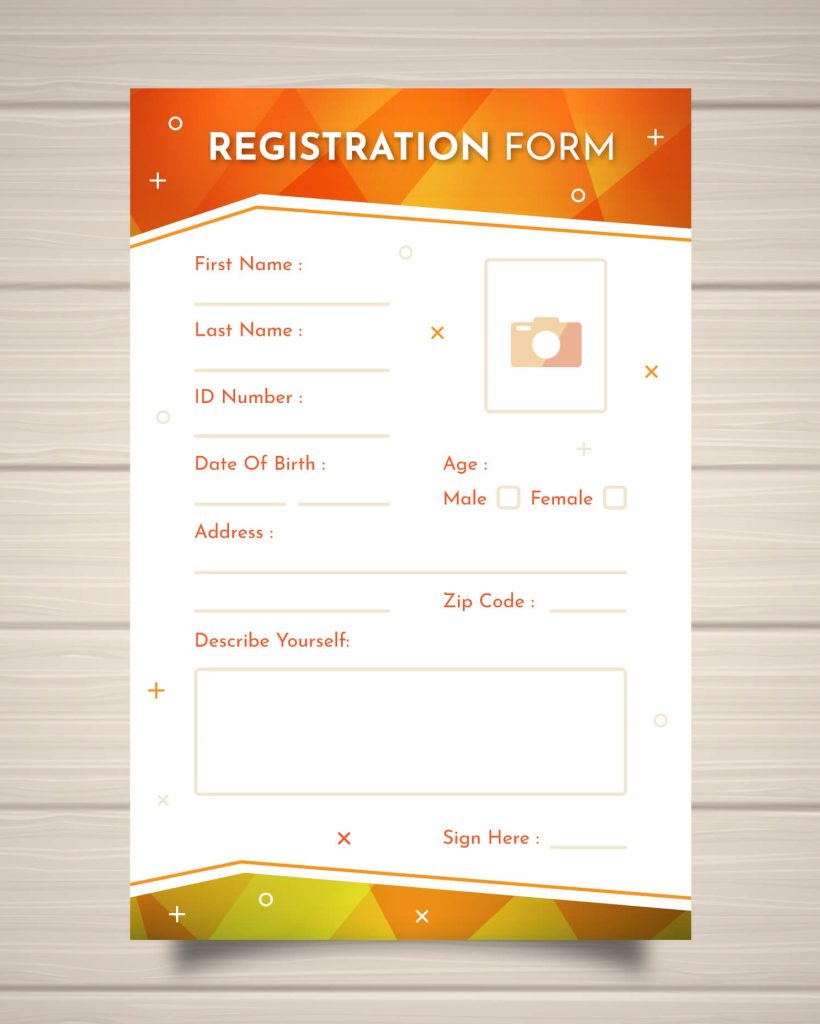Let’s talk about how many times we have clicked away from an online event registration form in pure frustration. No one wants to dedicate time towards those endless fields, confusing layouts, and convoluted processes as not only does it take time but in the end, leaves everyone flabbergasted. We have all been there! However, the truth is event registration forms are often overlooked. But they play an important role in deciding your event’s success.
In this comprehensive blog, we’re going to talk about how to create an online event registration form, focusing on the features you need, a basic registration form template and all the essential details that’ll make your attendees feel amazed. Let’s get the audience excited for your event, right from the very first click!
Understanding Online Event Registration Form

The online registration form is the first point of access to an event and the key to it. This is where potential participants convert their interest into confirmed participation in the event. As it’s considered the first contact, it should always be friendly and efficient.
Put simply, these forms gather information about attendees, including their names, contact information, government ID, the events they have selected and sometimes even their dietary preferences. These forms are crucial to running the event smoothly and providing a flawless experience for all attendees. With online event registration forms, it’s easier to manage event logistics, send updates and understand attendee behavior and preferences.
However, a simple event registration form helps event organizers to tailor their event according to the needs, interests and preferences of attendees while making them feel valued.
Now let’s know more about the importance of the event registration form.
Why There’s a Need For an Online Event Registration Form?
Here mentioned are the ten key factors that showcase the importance of event registration forms. Let’s delve into it;
1. Improve Attendee Experience: No one enjoys struggling through confusing event registration forms. Therefore, incorporate simplicity because it translates to a smoother experience for attendees and in organizing an event as well.
2. Data Done Right: Clear and simple event registration forms make it easier for attendees to enter accurate information which leads to better planning and execution for your event.
3. Embrace the Spontaneity: Online event registration forms encourage last-minute event registration which potentially boosts your attendee attendance.
4. Budget Bliss: An online event registration form template can save a lot of money by creating a user-friendly, DIY form and eliminating the need for expensive form registration software.
5. Analytics Advantage: Having registration forms can help with streamlined data collection which further makes analyzing attendee demographics and preferences super easy.
6. Break Down Language Barriers: Simple event registration forms with clear instructions can be easily translated for a wider audience.
7. Multitasking Made Easy: To remove the hassle for attendees, online registration forms allow participants to register while juggling their busy schedules with a quick and painless process.
8. Marketing Magic: Ever thought of using registration forms in promotion/marketing? Well, these forms strategies registration data to personalize future event marketing efforts and target the right audience.
9. Leave a Lasting Impression: A positive event registration experience sets the stage for a memorable and successful event which leaves attendees amazed.
10. Future-Proof Your Events: Simple event registration forms are easily adaptable for future events, not only it saves time but helps in better allocation of resources.
What Should a Basic Online Event Registration Form Template Look Like?

Here’s a perfect basic template for the event registration form. Consider this for a solid foundation for most event registration needs. The best part is that you can customize it further based on your specific event.
Basic Information
1. Full Name:
- First Name
- Last Name
2. Date of Birth:
- Day
- Month
- Year
3. Gender:
- Male
- Female
- Other
- Prefer not to say
4. Contact Information:
- Email Address
- Phone Number
5. Mailing Address:
- Street Address
- City
- State/Province
- Postal/ZIP Code
- Country
Professional Information
6. Organization/Company Name:
7. Job Title/Position:
8. Industry/Sector:
Event Participation
9. Event Sessions/Workshops (Select the sessions you plan to attend):
- Session 1: [Title] (Date, Time)
- Session 2: [Title] (Date, Time)
- Workshop 1: [Title] (Date, Time)
- Workshop 2: [Title] (Date, Time)
Preferences and Requirements
10. Meal Preferences:
- Vegetarian
- Vegan
- Gluten-Free
- No Preference
- Other (please specify)
11. Special Requirements:
- Accessibility Needs
- Dietary Restrictions
- Other (please specify)
Payment Information
12. Registration Fee:
- Early Bird (Before [Date]): $XX.XX
- Standard (After [Date]): $XX.XX
13. Payment Method:
- Credit/Debit Card
- PayPal
- Bank Transfer
14. Billing Information (if different from Mailing Address):
- Name on Card
- Card Number
- Expiry Date (MM/YY)
- CVV
- Billing Address
- Street Address
- City
- State/Province
- Postal/ZIP Code
- Country
Additional Information
15. How did you hear about this event?:
- Email Newsletter
- Social Media
- Referral
- Website
- Other (please specify)
16. Would you like to receive updates about future events?:
- Yes
- No
17. Emergency Contact Information:
- Full Name
- Relationship
- Phone Number
Consent and Acknowledgment
18. Consent for Photography/Video:
- I consent to being photographed/filmed during the event for promotional purposes.
- I do not consent.
19. Terms and Conditions:
- I have read and agreed to the [Event Name] Terms and Conditions.
Signature
20. Signature:
[Signature Field]
This online event registration form template comprehensively covers all aspects of registration from basic personal details to advanced preferences and consents. Also, this can be modified according to categories and attendee preferences. Additionally, you can use no code online form builder to create your registration form without extra effort. Now let’s walk through the must-have features of the event registration form.
Must-Have Features of Online Event Registration Form
Creating an effective simple event registration form is crucial for the success of your event. Here are the must-have features to include in your event registration form:
Visually Appealing and Well-Structured Layout
The first thing that comes to mind when thinking about registering forms is layout. It’s the very first thing that grabs the attention of attendees. Ensure that the registration form seems appealing and easy to navigate. Furthermore, well-structured online event registration forms designed specifically for an event will ensure a seamless event registration process by eliminating unnecessary or irrelevant questions.
Multiple Registration Options for Different Ticket Types
A simple event registration form should always be customizable to gather all the essential information such as attendee name, contact details, response to questions, or any required payment details. However, every attendee is different therefore it’s important to provide multiple registration options. This includes various attendee types, such as general visitors, speakers, VIPs, students, groups etc. As a result, this flexibility improves attendee experiences and allows you to gather a variety of participants. Moreover, offering different ticket types also streamlines data collection, making it easier to analyze the audience and current industry trends.
Mobile Responsiveness

Undoubtedly we are living in a mobile-centric world, which automatically makes an online event registration form mobile-friendly. Some attendees might use their mobile instead of laptop/computers, therefore both, registration form and mobile event app should adapt well with different devices to be more accessible. This mobile-responsiveness ensures a successful event registration process.
Read More: Best 8 Fastest Mobile Event Check-in Apps
Mandatory Fields

Ensure that a simple event registration form includes all mandatory fields in the form to gather essential information needed to track event progress. How do these mandatory fields function? It prevents duplicate event registrations, reduces confusion about attendance numbers and ensures you have accurate data on your attendees.
Built-in Data Validation
To improve the accuracy of your registration data, include data validation checks on your online event registration forms. Make sure phone numbers match the selected country and that email addresses are correctly formatted and come from valid domains. This will help prevent fake registrations and reduce the chances of unauthorized entries.
By including these key features, you’ll create a user-friendly registration form that improves the attendee experience and gives you useful insights for planning your event.
Create an Online Event Registration Form: Essential Do’s and Don’ts
Here are some tips to consider while planning your online event registration form template. Let’s discuss them;
Do’s:
- Prioritize Clarity and Transparency: Ensure that registration forms focus on providing clear and concise details about the event which includes all the essential information
- Position the Registration Form for Visibility: Clear CTA button should be visible on the event’s website and registration form too.
- Optimize Form Length and Functionality: Online event registration form template should have limited fields, clear labels and a professional layouts.
- Enhance User Experience: Minimize technical hurdles and ensure mobile responsiveness during the registration process.
- Encourage Timely Registrations: Publish the registration form on event registration platform strategically. Consider travel needs, and employ deadlines or countdown timers when appropriate.
Don’ts:
- Obscure Essential Information: Don’t clutter the form with excessive content which includes promotional content. Provide transparency and clarity to attendees by offering them clear details regarding events (who, what,when, where). Also ensure that all necessary information is easily accessible.
- Hide the Registration Form: Don’t make your form obscured on the event registration landing page. Avoid adding layers of content to the registration form. A clear call to action button such as register now, submit registration, done should be strategically placed in order to guide attendees.
- Overwhelm with Length: As we have discussed this earlier, no one wants to fill lengthy forms. Limit the number of required fields to minimum. Use clear & concise fields labels to avoid confusions and ensure accurate data security.
- Neglect Technical Considerations: Don’t use numerous plugins or integrate additional tools into the form. As it could lead to form abandonment. Keep your event registration platform streamlined and user-friendly for less or no technical issues.
- Forget Mobile Optimization: Ensure the registration form is optimized for seamless navigation and also compatible with mobile event apps. However, make sure that your event registration platform should provide a smooth experience across all devices, so that attendees can join-in from anywhere.
Conclusion
By the end of this blog, it’s clear that for a successful event it’s important to create an online event registration form that’s not just user-friendly but also informative. If you prioritize a seamless experience for your attendees, it not only boosts event registrations but also gathers all the valuable data to tailor future events. In this guide, we’ve covered the knowledge and tips that are required to create an online event registration form. Always pin that, a registration form should be simple, filled with clarity, and of course not lengthy at all.
So are you ready to get started? Utilize the above mentioned template as a base for your forms and customize it accordingly. With a user-friendly registration form, you’ll be on your way to welcome a crowd of excited attendees!
FAQs
1. What is event registration and how does the registration form affect event registration?
Event registration is the process of registering or signing up to attend an event. It’s a part of event planning where individuals register themselves to be a part of an event. The registration form is one of the most crucial tools in this process as it gathers information about attendees and assists event planners in management of event attendance effectively.
2. What are the programming languages used in event registration form templates?
Event registration form templates typically use HTML for structuring the form, CSS for styling it, and JavaScript for adding interactivity (such as form validation). Server-side languages like PHP, Python, or Ruby may also be used to process email to HTML event registration form submissions and store data.
3. How do you create a form step by step?
To create a simple online event registration form, follow these basic steps:
1. HTML Structure: Write HTML code to define the form and its elements (input fields, checkboxes, etc.).
2. CSS Styling: Use CSS to style the form elements to match your design.
3. JavaScript (optional): Add JavaScript for client-side validation or to enhance interactivity.
4. Server-side Processing: Use a server-side language (like PHP, Python, etc.) to handle form submissions and store data.








